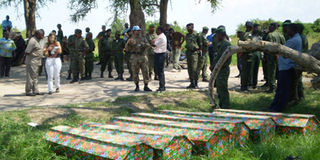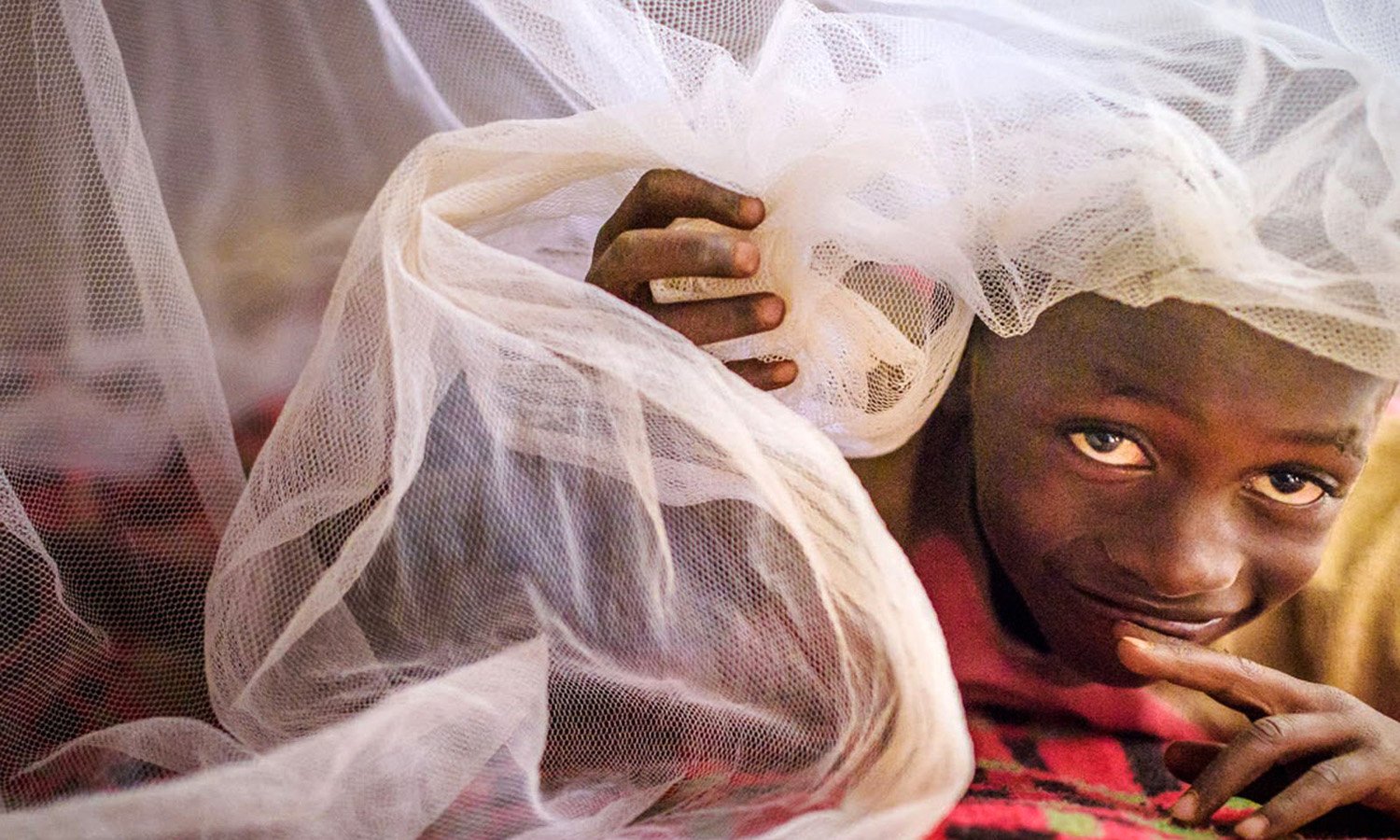Army, oil firm cited in L. Albert killings

MONUC officials parade six caskets of the Congolese who were allegedly killed by UPDF soldiers on Lake Albert five years ago. COURTESY PHOTO
What you need to know:
In September 2007, the UPDF allegedly opened fire on a Congolese ferry. But the army denies the allegation.
Five years since the killing of six Congolese, including a three-year-old child on Lake Albert, new information published today shows Heritage Oil and Gas, a company which was once the biggest operator in Uganda’s fledgling oil sector, played a key role in triggering the fatal UPDF operation which led to their deaths.
The Ugandan army has always denied there were civilian deaths, insisting even last evening that this was an operation in which its forces exchanged fire with Congolese troops.
But two previously unreleased photos – showing bloodied civilian casualties in a wooden boat, and six coffins - start to tell the story about what may have happened on September 24, 2007.
The incident, in which the Ugandan army opened fire on a Congolese passenger ferry, was a direct consequence of the British oil company making a request for military assistance after its Ugandan exploration team had strayed over the DR Congo border.
Despite the controversy over what happened on September 24, 2007, no full investigation was pursued by Heritage or Uganda.
Corporate Watch, a UK research group, is today publishing material that exposes a likely attempt at a cover-up and raises further concerns over oil production in the Great Lakes region.
But when contacted yesterday, Army Spokesman Col. Felix Kulayigye rejected the information provided in the new report as false. “It is twisting the facts to suit interests that are only known to the writers and I condemn it with the contempt it deserves,” Col Kulayigye said in a telephone interview.
“If we were the ones in the wrong, the standard procedure is that we promise an investigation into the matter, and still produce the findings of the investigations to the affected parties.”
Col. Kulayigye also said he does not remember any civilian deaths but he will have to “cross check with the records to see if there were any.” The UPDF has, in public, said it was attacked by two Congolese army soldiers on the ferry who refused to give up their AK-47s and disputed that anyone had been killed. But Congolese witnesses have accused the UPDF units which reportedly arrived in three patrol boats of firing indiscriminately almost as soon as they arrived.
A UN fact-finding report, seen by Corporate Watch, also reveals that a three-year-old child was among the dead. The Ugandan military is reported to have confirmed to the UK High Commission in Kampala at the time that its soldiers were on a “rescue mission” to help the Heritage team when it encountered the Congolese boat, according to a British foreign office email sent by a Mr John Hamilton in 2007 and obtained through a Freedom of Information request by oil watchdog, Platform.
Leaks to public
Mr Hamilton was the second secretary at the UK High Commission at the time in Kampala.The email was the first public revelation of information reportedly exchanged between the British government and the Ugandan military about the incident.
Yesterday, an information officer at the UK mission declined to comment, saying he would pass on Daily Monitor’s request for an interview to his superior. No response had been received by press time.
A September 26 leaked US diplomatic cable released by whistleblower website wikileaks also confirms Heritage “mistakenly thinking that the approaching (UN) boats belonged to ‘negative forces’ put out an SOS call to which the UPDF’s patrol boats responded”. The cable also quotes information about a high ranking Uganda military officer directing the UPDF patrol boats not to approach Kasenyi.
The new evidence directly contradicts Heritage’s claim at the time that the deaths were a “separate, unrelated, isolated incident” involving “no employees or subcontractors” of the company.
Oil production is due to begin later this year after a decade of controversial exploration. Heritage’s former partner, Tullow Oil, was a 50-50 partner in Block 3A when the incident occurred, raising questions about what representations they made to Heritage, which was the operator on Block 3A, after the deaths became known.
When contacted, Tullow Oil, which took over operations from Heritage in 2010, distanced itself from any wrongdoing at that time, and in that particular incident.
The oil company’s spokesperson, Mr Jimmy Kiberu, told Daily Monitor from Nairobi that at the time the incident happened, “it was entirely Heritage in that area because we had not acquired its rights and our operations were entirely distinctive from theirs.”
Tullow and Heritage were also joint signatories to a 2006 Production Sharing Agreement on the Congolese side of Lake Albert. Tullow made no public comment after the deaths and did not publish any consideration of the risk of the exploration project.
Events unfold
The chain of events that led to the Lake Albert killings began when a Heritage Uganda exploration boat, which had illegally entered Congolese waters, was escorted to the DR Congo shore by a UN patrol trying to establish the identity of the rogue vessel at around 1pm.
The Heritage crew made the “rescue mission” call to the Ugandan army, which sent three military boats. Almost half an hour later, one of those boats opened fire on the ferry. A joint investigation by the UN Mission in Congo (Monuc) and a Congolese team concluded that the UPDF had “started firing indiscriminately” at the ferry.
It said “six people died, five were wounded,” their report added. “Three critically wounded children are being evacuated to MSF / Bunia [nearest Medicin Sans Frontieres clinic]. One and half year old child, among the wounded, lost his mother in the shootout.”
The internal Foreign Office email sent from Kampala on September 25, 2007 confirms that Uganda had indeed reacted following a Heritage request for military assistance.
Before the release of the Heritage team by the UN, the Ugandans had moved into action.
The FCO emails reads: “In a version of events which the Ugandan military spokesperson has subsequently confirmed to us, a UPDF ‘rescue mission’ is said to have encountered a FARDC [Congolese army] vessel while investigating the disappearance of the Heritage Oil boat.”
Routine checkup
In its only comment on the L.Albert fiasco, buried in a drilling report dated September 25, 2007, Heritage claimed the UN boat that made contact with its vessel was “a routine check, not hostile” and that its vessel was “within Ugandan waters in the process of lifting cables to mark the completion of the seismic survey”.
The company said this month it had “no further comment to make”. “Heritage called in the cavalry, and six civilians were killed,” Mika Minio of Platform said. “The company’s close cooperation with the UPDF in militarising Lake Albert clearly led to this tragedy, even though Heritage later colluded in covering up the events.”
The panic on the day may have been caused by a similar incident the previous month.
Witnesses say at 1.30pm, halfway through the passenger ferry’s journey, a dozen soldiers from the UPDF suddenly pulled up alongside in a military boat, guns at the ready. Soon after, the shooting started.
A senior UN source said Ugandan claims that the passenger ferry was in fact a Congolese army boat are “complete nonsense” and that it was Heritage’s mistaken panic over the fate of its party that triggered Uganda’s military escalation.
The US cable also says Lt. Gen. Katumba Wamala, commander of land forces, was in “real-time” radio contact with one of the UPDF boats, raising questions about who knew how the firing started and when.
Rukwanzi residents told Daily Monitor on a visit to the island in 2009 that the families of the deceased had been promised $100 in compensation by the Congolese authorities but they never received the money.
Additional reporting by Isaac Imaka




